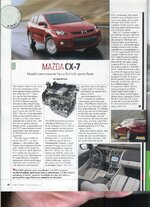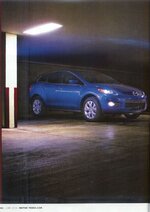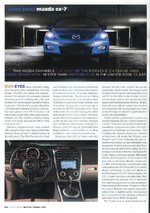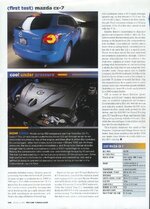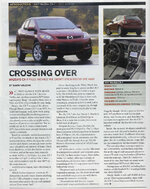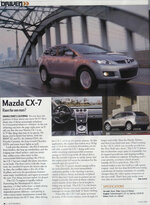Post links in this group of reviews:
http://www.thestar.com/NASApp/cs/ContentServer?pagename=thestar/Layout/Article_Type1&c=Article&cid=1142549412696&call_pageid=970599119419
* Antoine here...Great Review! by Jim Kenzie:
TUSTIN, Calif.The term "crossover" in the automobile world is like the phrase "business casual" in the dress code world: nobody really knows what it means.
A crossover can be anything from a minivan dipped in gold (Chrysler Pacifica), to a jacked-up station wagon (Subaru Outback) to a purpose-built vehicle like today's subject, the Mazda CX-7.
What all these vehicles have in common or at least strive for is to combine the carrying capacity and practicality of a minivan, without the soccer-mom stigma associated with these things, especially in the United States; and the tall seating position and go-anywhere capability of an SUV, without their stigma for wasting the earth's resources, or the associated penalities of ride, handling, safety and weight.
The CX-7 originated in the fertile minds of Mazda's North American research and development centre in nearby Irvine, from whence many years ago also emerged the concept for the Miata.
In response to a query from the Hiroshima head office about what sort of vehicles Mazda needed to succeed on this continent, Robert Davis, Mazda Motors North America's senior vice-president, product development and quality, and his team chose a compact crossover/SUV as the first of a list of three such North America-priority vehicles that will be appearing over the next year or so.
With this facility's history with the Miata, it's not surprising that they also wanted to dial in a dash of sportiness.
The CX-7 first broke cover at the Detroit auto show in 2005 as the MX-Crossport concept vehicle. At that point, it was about halfway into its 26-month gestation period and even then it was clear the vehicle was production-intended.
The concept's sleek lines have survived into the real deal almost intact which, according to program manager Shunsuke Kawasaki, proved something of a challenge to the engineers.
"For instance, it was hard to make the high seating position work with the fast (steeply laid-back) windshield and still pass crash tests," he said.
The broad-shouldered front fenders and strong character lines leading from the sides of the grille to the windshield pillars are strongly reminiscent of the RX-8 and the new MX-5 Miata, helping establish a consistent brand identity as well as strengthening the sporting connection.
The roof slants downwards as it moves rearward, and the upper body also tapers inwards, making the car look smaller if you're following it than if it is gaining on you.
In all, it is an eye-catching, handsome and unique look.
The interior features what Kawasaki calls a dual-roof instrument panel: a small eyebrow over a line of digital readouts, with a deeper cowl over the main dash. A three-circle set of dials keeps you aware of what's happening with the oily bits.
The CX-7 is a two-row, five-seat vehicle.
"The buyer of a vehicle like this is typically a young married couple, with maybe one child, and has no interest in a three-rows-of-seats SUV," says a Mazda U.S. spokesman. "But they do want lots of room for their stuff."
This is aided by the split-folding rear seat backs, which borrow the oh-so-easy single-flick-of-a-lever release mechanism from the Mazda6 wagon and hatchback.
Mechanically, the CX-7 borrows bits from all across the Mazda product spectrum. Contrary to some reports, it is not based on the same platform as the soon-to-be-Oakville-built Ford Edge and Lincoln MK X, which are more closely related to Mazda's new Japan-only MPV minivan.
"Those three are more like siblings to each other, but cousins to the CX-7," said Kawasaki.
The front MacPherson strut suspension is similar though, while the rear is closer to that of the Mazda3 and Mazda5, although the lower mounting point for the rear dampers has been moved from the bottom of the upright to the top, to allow clearance for the rear drive shafts in the optional four-wheel drive system.
The only engine offered is a 2.3 litre turbocharged twin-cam 16-valve four-cylinder, lifted essentially intact from the Mazdaspeed6 high-performance sedan. It produces 244 horsepower at 5000 r.p.m., and a healthy 258 lb.-ft. of torque which peaks at a low 2500 r.p.m., and continues to no less than 99 per cent of that value right up to 5000 r.p.m.
It is what Mazda calls a DISI (pronounced dizzy) engine, standing for Direct Injection, Spark Ignition. Like a diesel, fuel is sprayed directly into the combustion chamber for improved atomization, leading to increased power and reduced consumption and emissions. Unlike a diesel, of course, there is a spark plug.
The usual downside to direct injection is noise; the turbocharger helps to mask this to a degree.
The engine has been re-tuned somewhat to work in concert with the CX-7's only available transmission, a six-speed automatic with manual shift over-ride. (The Mazdaspeed6 comes only with a six-speed manual.)
The CX-7's four-wheel drive system is the same as that on the Mazdaspeed6 too, a full-time deal that sends up to 50 per cent of the torque to the rear axle depending on front-wheel slippage. There's also a Torsen limited-slip differential at the rear.
Big four-wheel ventilated disc brakes with ABS, Electronic Brake Force Distribution (assuring each wheel gets maximum possible braking force before ABS cuts in), traction control and directional stability control are all standard.
If all that doesn't bail you out, six airbags dual front, dual side and side curtains just might.
Two trim levels will be offered in Canada: the GS at $31,995 gets the now-expected stuff like air-con, power windows, mirrors and locks with remote keyless entry, cruise and a four-speaker AM-FM stereo audio system, the latter two features both with steering-wheel-mounted controls.
Heated exterior mirrors are a nice touch for our climate.
Major options include a sunroof ($1,000) and four-wheel drive ($2,000).
The GT model at $35,195 adds the sunroof, plus Xenon headlights, leather-trimmed upholstery, heated front seats, power adjustment for the driver's seat, automatic air-con, rear cargo cover and upgraded interior and exterior trim.
Options include again four-wheel drive ($2,000), a Luxury package ($1,000 a nine-speaker premium BOSE audio system with surround sound and a six-CD changer, plus a key fob-activated smart-key ignition system) and DVD-based satellite navigation with touch-screen control ($3,150).
Tony Harold, manager of product strategies and development for Mazda Canada, figures the GS/GT split of the expected 5,000 annual sales will be about 50/50, with maybe 55 per cent in total opting for the four-wheel drive system. What do I know, but my guess is that it'll be higher that that in our country, why would you not?
We didn't get the chance to evaluate the all-weather traction capabilities of the CX-7 during our preview drive another boring day in the paradise that is southern California.
But the well-paved two-lane twisties did display this car's remarkable nimbleness. It really does feel considerably smaller than it looks and quite agile despite its not-inconsequential weight of 1,784 kg (for the four-wheel drive version I drove; the front-drive model is 101 kg lighter).
The handling is very nice: all of these genetically-linked Ford/Mazda/Volvo-badged cars have terrific steering and a flat cornering stance, and this one is no different despite its taller height.
Ride quality is also good: firm enough to give confidence that it can handle a fairly decent cargo load, but never too harsh.
The engine pulls strongly from very low revs and turbo lag is never in evidence. The exhaust note gets a little raucous at higher r.p.m., making me wonder whether maybe some slices of the intended market might prefer the quiet and smoothness of a V6 over the extra urge of the turbo four.
Program manager Kawasaki assured me that a V6 would not be consistent with the sporty character they want this vehicle to deliver. It's a moot point in any case, since he also said a V6 wouldn't fit in the CX-7's engine bay.
The transmission shifts well in either automatic or manual mode. The manual over-ride follows the race-car sequential shift concept of pulling back on the shift lever to upshift it is more logical, since you're being thrust back into the seat under acceleration and it makes sense to pull back to move up a ratio; likewise, under braking you're thrust forward, so a forward motion of the level makes sense to downshift.
The only problem is that virtually everyone else does it backwards, and customers coming into a CX-7 from any other manufacturer with a manual over-ride automatic may get confused, at least initially.
My only other minor concern is that perhaps the shift lever itself is a bit too far back on the centre console for optimum reach as the console interfered with my elbow in spirited driving.
The seats are comfortable and supportive, the rear seat is commodious and the tapered roofline doesn't compromise headroom, at least not for my 168 cm frame. The luggage area is deep and wide, with a low lift-over.
The floor of the cargo hold is carpeted on one side, with hard plastic on the other. Hauling peat moss or dirt bikes? Flip it over, then remove it when you get home and hose it off. Clever.
Mazda is aiming the CX-7 at customers who currently shop price-similar vehicles like Honda CR-V (by far the segment leader) or Toyota RAV4, although from a style and image perspective, they have the considerably more expensive Nissan Murano in their sights.
The CX-7 appears to have the goods to succeed. It's an SUV when necessary, but not necessarily an SUV.
Can't get more Canadian than that.
http://www.thestar.com/NASApp/cs/ContentServer?pagename=thestar/Layout/Article_Type1&c=Article&cid=1142549412696&call_pageid=970599119419
* Antoine here...Great Review! by Jim Kenzie:
TUSTIN, Calif.The term "crossover" in the automobile world is like the phrase "business casual" in the dress code world: nobody really knows what it means.
A crossover can be anything from a minivan dipped in gold (Chrysler Pacifica), to a jacked-up station wagon (Subaru Outback) to a purpose-built vehicle like today's subject, the Mazda CX-7.
What all these vehicles have in common or at least strive for is to combine the carrying capacity and practicality of a minivan, without the soccer-mom stigma associated with these things, especially in the United States; and the tall seating position and go-anywhere capability of an SUV, without their stigma for wasting the earth's resources, or the associated penalities of ride, handling, safety and weight.
The CX-7 originated in the fertile minds of Mazda's North American research and development centre in nearby Irvine, from whence many years ago also emerged the concept for the Miata.
In response to a query from the Hiroshima head office about what sort of vehicles Mazda needed to succeed on this continent, Robert Davis, Mazda Motors North America's senior vice-president, product development and quality, and his team chose a compact crossover/SUV as the first of a list of three such North America-priority vehicles that will be appearing over the next year or so.
With this facility's history with the Miata, it's not surprising that they also wanted to dial in a dash of sportiness.
The CX-7 first broke cover at the Detroit auto show in 2005 as the MX-Crossport concept vehicle. At that point, it was about halfway into its 26-month gestation period and even then it was clear the vehicle was production-intended.
The concept's sleek lines have survived into the real deal almost intact which, according to program manager Shunsuke Kawasaki, proved something of a challenge to the engineers.
"For instance, it was hard to make the high seating position work with the fast (steeply laid-back) windshield and still pass crash tests," he said.
The broad-shouldered front fenders and strong character lines leading from the sides of the grille to the windshield pillars are strongly reminiscent of the RX-8 and the new MX-5 Miata, helping establish a consistent brand identity as well as strengthening the sporting connection.
The roof slants downwards as it moves rearward, and the upper body also tapers inwards, making the car look smaller if you're following it than if it is gaining on you.
In all, it is an eye-catching, handsome and unique look.
The interior features what Kawasaki calls a dual-roof instrument panel: a small eyebrow over a line of digital readouts, with a deeper cowl over the main dash. A three-circle set of dials keeps you aware of what's happening with the oily bits.
The CX-7 is a two-row, five-seat vehicle.
"The buyer of a vehicle like this is typically a young married couple, with maybe one child, and has no interest in a three-rows-of-seats SUV," says a Mazda U.S. spokesman. "But they do want lots of room for their stuff."
This is aided by the split-folding rear seat backs, which borrow the oh-so-easy single-flick-of-a-lever release mechanism from the Mazda6 wagon and hatchback.
Mechanically, the CX-7 borrows bits from all across the Mazda product spectrum. Contrary to some reports, it is not based on the same platform as the soon-to-be-Oakville-built Ford Edge and Lincoln MK X, which are more closely related to Mazda's new Japan-only MPV minivan.
"Those three are more like siblings to each other, but cousins to the CX-7," said Kawasaki.
The front MacPherson strut suspension is similar though, while the rear is closer to that of the Mazda3 and Mazda5, although the lower mounting point for the rear dampers has been moved from the bottom of the upright to the top, to allow clearance for the rear drive shafts in the optional four-wheel drive system.
The only engine offered is a 2.3 litre turbocharged twin-cam 16-valve four-cylinder, lifted essentially intact from the Mazdaspeed6 high-performance sedan. It produces 244 horsepower at 5000 r.p.m., and a healthy 258 lb.-ft. of torque which peaks at a low 2500 r.p.m., and continues to no less than 99 per cent of that value right up to 5000 r.p.m.
It is what Mazda calls a DISI (pronounced dizzy) engine, standing for Direct Injection, Spark Ignition. Like a diesel, fuel is sprayed directly into the combustion chamber for improved atomization, leading to increased power and reduced consumption and emissions. Unlike a diesel, of course, there is a spark plug.
The usual downside to direct injection is noise; the turbocharger helps to mask this to a degree.
The engine has been re-tuned somewhat to work in concert with the CX-7's only available transmission, a six-speed automatic with manual shift over-ride. (The Mazdaspeed6 comes only with a six-speed manual.)
The CX-7's four-wheel drive system is the same as that on the Mazdaspeed6 too, a full-time deal that sends up to 50 per cent of the torque to the rear axle depending on front-wheel slippage. There's also a Torsen limited-slip differential at the rear.
Big four-wheel ventilated disc brakes with ABS, Electronic Brake Force Distribution (assuring each wheel gets maximum possible braking force before ABS cuts in), traction control and directional stability control are all standard.
If all that doesn't bail you out, six airbags dual front, dual side and side curtains just might.
Two trim levels will be offered in Canada: the GS at $31,995 gets the now-expected stuff like air-con, power windows, mirrors and locks with remote keyless entry, cruise and a four-speaker AM-FM stereo audio system, the latter two features both with steering-wheel-mounted controls.
Heated exterior mirrors are a nice touch for our climate.
Major options include a sunroof ($1,000) and four-wheel drive ($2,000).
The GT model at $35,195 adds the sunroof, plus Xenon headlights, leather-trimmed upholstery, heated front seats, power adjustment for the driver's seat, automatic air-con, rear cargo cover and upgraded interior and exterior trim.
Options include again four-wheel drive ($2,000), a Luxury package ($1,000 a nine-speaker premium BOSE audio system with surround sound and a six-CD changer, plus a key fob-activated smart-key ignition system) and DVD-based satellite navigation with touch-screen control ($3,150).
Tony Harold, manager of product strategies and development for Mazda Canada, figures the GS/GT split of the expected 5,000 annual sales will be about 50/50, with maybe 55 per cent in total opting for the four-wheel drive system. What do I know, but my guess is that it'll be higher that that in our country, why would you not?
We didn't get the chance to evaluate the all-weather traction capabilities of the CX-7 during our preview drive another boring day in the paradise that is southern California.
But the well-paved two-lane twisties did display this car's remarkable nimbleness. It really does feel considerably smaller than it looks and quite agile despite its not-inconsequential weight of 1,784 kg (for the four-wheel drive version I drove; the front-drive model is 101 kg lighter).
The handling is very nice: all of these genetically-linked Ford/Mazda/Volvo-badged cars have terrific steering and a flat cornering stance, and this one is no different despite its taller height.
Ride quality is also good: firm enough to give confidence that it can handle a fairly decent cargo load, but never too harsh.
The engine pulls strongly from very low revs and turbo lag is never in evidence. The exhaust note gets a little raucous at higher r.p.m., making me wonder whether maybe some slices of the intended market might prefer the quiet and smoothness of a V6 over the extra urge of the turbo four.
Program manager Kawasaki assured me that a V6 would not be consistent with the sporty character they want this vehicle to deliver. It's a moot point in any case, since he also said a V6 wouldn't fit in the CX-7's engine bay.
The transmission shifts well in either automatic or manual mode. The manual over-ride follows the race-car sequential shift concept of pulling back on the shift lever to upshift it is more logical, since you're being thrust back into the seat under acceleration and it makes sense to pull back to move up a ratio; likewise, under braking you're thrust forward, so a forward motion of the level makes sense to downshift.
The only problem is that virtually everyone else does it backwards, and customers coming into a CX-7 from any other manufacturer with a manual over-ride automatic may get confused, at least initially.
My only other minor concern is that perhaps the shift lever itself is a bit too far back on the centre console for optimum reach as the console interfered with my elbow in spirited driving.
The seats are comfortable and supportive, the rear seat is commodious and the tapered roofline doesn't compromise headroom, at least not for my 168 cm frame. The luggage area is deep and wide, with a low lift-over.
The floor of the cargo hold is carpeted on one side, with hard plastic on the other. Hauling peat moss or dirt bikes? Flip it over, then remove it when you get home and hose it off. Clever.
Mazda is aiming the CX-7 at customers who currently shop price-similar vehicles like Honda CR-V (by far the segment leader) or Toyota RAV4, although from a style and image perspective, they have the considerably more expensive Nissan Murano in their sights.
The CX-7 appears to have the goods to succeed. It's an SUV when necessary, but not necessarily an SUV.
Can't get more Canadian than that.


